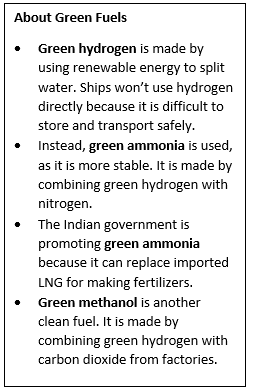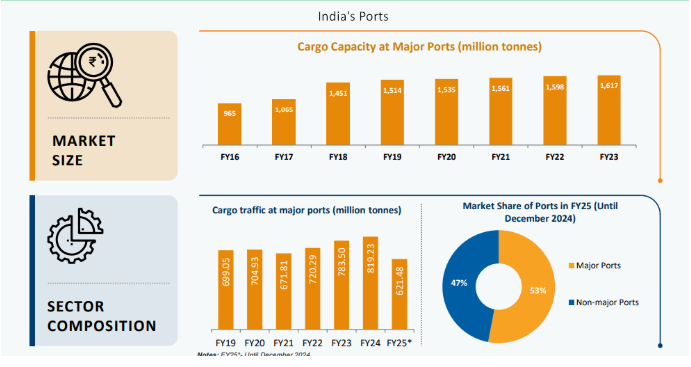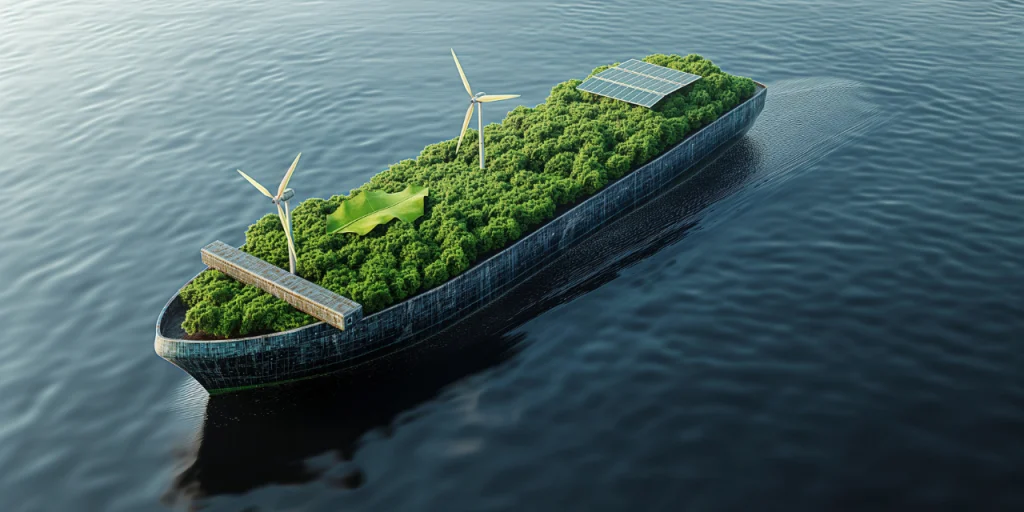Syllabus
GS: 3 Environment
Context: – Global shipping plans to cut its carbon emissions a lot by 2040-2050 because of growing climate concerns and worldwide goals to reduce pollution.
Key Highlights
- This is a big opportunity for India. Most cargo ships currently use fuels like Very Low Sulphur Fuel Oil (VLSFO), diesel and liquefied methane.
- Ships using LNG (liquefied natural gas) engines are more efficient and may act as a temporary solution until cleaner fuels like green ammonia, green methanol and biofuels are adopted by 2040 to reach net zero emissions.
Ideal Fuel for shipping industry

- The shipping industry is slow to adopt new technology.
- Since ammonia engines are still new, ships are first switching to green methanol which emits about 10% of carbon dioxide compared to traditional fuels.
- Later, they may shift to green ammonia, which produces no greenhouse gases.
- However, using ammonia is more complex and needs special equipment onboard.
- Green methanol is easier to use. It can replace traditional fuel (VLSFO) with only small changes and can be stored as a liquid at room temperature, unlike ammonia or LNG.
- Already, over 360 methanol-powered ships are operating or have been ordered.
- In February, 100% sustainable e-methanol cost about $1,950 per tonne in Singapore, while VLSFO cost around $560 per tonne.
- The high cost is due to the price of renewable electricity (10–11 MWh per tonne of methanol) and the expensive electrolyser plants needed to make it.
- By 2028, the demand for green methanol may reach 14 million tonnes but supply is expected to be only around 11 million tonnes, which may lead to even higher prices.
India’s role in decarbonisation shipping
- India plans to reduce pollution from its shipping sector by using green fuels and setting up fuel supply points at ports like Tuticorin and Kandla.
- It also aims to produce and export green fuels to Singapore, a major global ship refuelling hub.
- With its large land area and solar energy expertise, India has the potential to become a key supplier of green fuels for global shipping.
- Ministry of ports launch Heritage Sagar Guideline 2023 with aim for green port operation, clean fuel, shore power for vessels and waste management.
- Partnering with IMO’s GreenVoyage2050 project to support low-carbon shipping pathways.
- India hosted the Green Shipping Conclave 2025 in Mumbai, showing its strong role in leading global efforts to reduce shipping emissions.
- India’s National Green Hydrogen Missionplans to make the country a global leader in green hydrogen production, which is important for making green ammonia and methanol – key clean fuels for shipping.
- India has set up a ₹25,000 crore Maritime Development Fund for FY26 to invest in green infrastructure, modern ships and clean fuels to meet IMO emission targets.
- Policies like Maritime India Vision 2030 also support global goals to reduce shipping emissions.
Way forward

- India should build green hydrogen production centres using its strong solar energy resources.
- It also needs to expand carbon capture and storage (CCS) technologies to make green methanol from industrial CO₂.
- The government should give policy and financial support, like Sovereign Guarantees, to reduce investment risks and make green methanol production affordable.
- PLI schemes can support the domestic manufacturing of electrolyser’s and help build robust green fuel supply chain.
- India can strengthen its shipping industry by giving incentives to build ships that can use green fuels in Indian shipyards.
- The budget of $10 billion to buy over 110 ships and making 10-20% of them green fuel-readywill lower costs and attract global shipbuilders.
- India should work with South Korea and Japan to get green shipping technologies and partner with countries like Singapore to increase its green fuel exports.
- Create Green Shipping Corridors (e.g., India–Sri Lanka–Singapore routes).
- Promote AI-based route optimisation, engine performance analytics to reduce fuel use by 5–10%.


